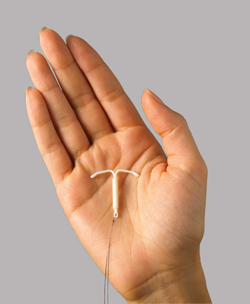Second of 2 parts: Let’s increase our use of implants and DMPA and improve contraceptive effectiveness in this county
Robert L. Barbieri, MD (Editorial, September 2012)
Malpositioned IUDs: When you should intervene
(and when you should not)
Kari P. Braaten, MD, MPH; Alisa B. Goldberg, MD, MPH (August 2012)
Update on Contraception
Tami Rowen, MD, MS; Mitchell D. Creinin, MD (August 2012)
Most studies indicate that the three available long-acting reversible contraceptives (LARCs)—
- copper intrauterine device (IUD)
- levonorgestrel-releasing intrauter-ine system (LNG-IUS)
- etonogestrel-releasing implant (Nexplanon)
—are the most effective reversible contraceptive methods. The injection of depot medroxyprogesterone acetate (DMPA) is also highly effective. In a large cohort study, by Winner and colleagues, of 7,486 women who were prescribed a reversible contraceptive, the contraceptive failure rate among women using a contraceptive pill, patch, or vaginal ring was 4.55 per 100 woman-years.1 For women using an IUD or etonogestrel implant, the contraceptive failure rate was 0.27 per 100 woman-years, and in women using DMPA, the contraceptive failure rate was 0.22. After adjusting for differences in age and education levels, the investigators found that women using the pill, patch, or vaginal ring were 21.8 times more likely to become pregnant than women using an IUD or etonogestrel implant.
As Drs. Rowen and Creinin note in their “Update on Contraception” on page 29 of this issue of OBG Management, approximately 49% of all pregnancies are reported to be unintended in the United States. A major contributing factor to this high rate of unintended pregnancy is that LARC methods are used at a low rate in the United States, compared with other developed countries.
The results of the study by Winner and colleagues, and other studies, support the notion that we could improve the effectiveness of our contraceptive interventions, and reduce the unplanned pregnancy rate, if we used LARCs more often. In this editorial, I focus on the expanding clinical indications for the use of the two available IUDs, the copper IUD (Figure 1) and the LNG-IUS (Figure 2), and propose, if you were asked to prescribe the most effective reversible contraceptive method in the three presented cases, what would you recommend?
In next month’s editorial, I will focus on the expanding indications for the use of the etonogestrel- releasing implant and DMPA.

FIGURE 1 ParaGard® Owned by Teva Pharmaceuticals Industries, Ltd.

FIGURE 2 Mirena® Published with the permission of Bayer HealthCare Pharmaceuticals Inc. A common misperception is that the IUD should not be used routinely in nulliparous women
CASE 1
A 30-year-old G0 woman was prescribed a contraceptive estrogen-progestin pill. Following a 14-hour international airplane flight she developed a lower extremity deep venous thrombosis (DVT). A thrombophilia evaluation revealed that she carried a factor V Leiden allele. She has just completed a 6-month course of warfarin and is requesting that you place an LNG-IUS.
Would you recommend an IUD in this nulliparous woman?
Evidence for IUD use in nulliparous women. Although IUDs are widely used in many developed countries, they are only used in about 6% of contracepting women in the United States.2 Many factors contribute to their limited use in this country, including beliefs about patient characteristics (nulliparity, adolescent age) that are relative contraindications to use. Yet recent evidence strongly supports expanding the number of patients eligible for IUDs. For instance, until relatively recently, the FDA labeling for IUDs recommended limiting their use to women who had at least one child. In 2005, however, the FDA changed its guidance and approved the copper IUD for use in nulliparous women. I believe the same guidance should be used for the LNG-IUS.
A theoretical concern is that an IUD could cause tubal infection and infertility, which could be a more devastating adverse effect of infection among nulliparous women than among women who have had one or more children. Among women at average risk for pelvic infection, there is a slight increase in the risk of pelvic infection in the first 20 days after insertion. After this time, the risk of pelvic infection among IUD users is the same as that among nonusers.3 Based on findings from a large observational study, investigators have reported that chlamydial infection is the most common cause of tubal infection and infertility, not the IUD.4
Based on this study, my conclusion is that IUDs do not cause tubal damage and infertility, rather undetected and untreated chlamydial infections are the primary cause of tubal damage and infertility.4
CASE 1: Conclusion
Given this patient’s history of DVT while taking an estrogen-progestin contraceptive, she is no longer eligible to use the estrogen-progestin pill, patch, or vaginal ring. I placed an LNG-IUS in this woman and she has been very pleased with this method of contraception.


